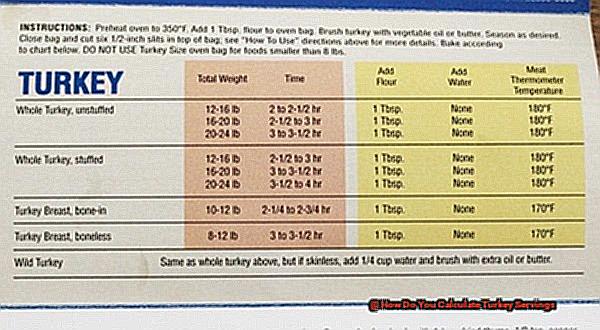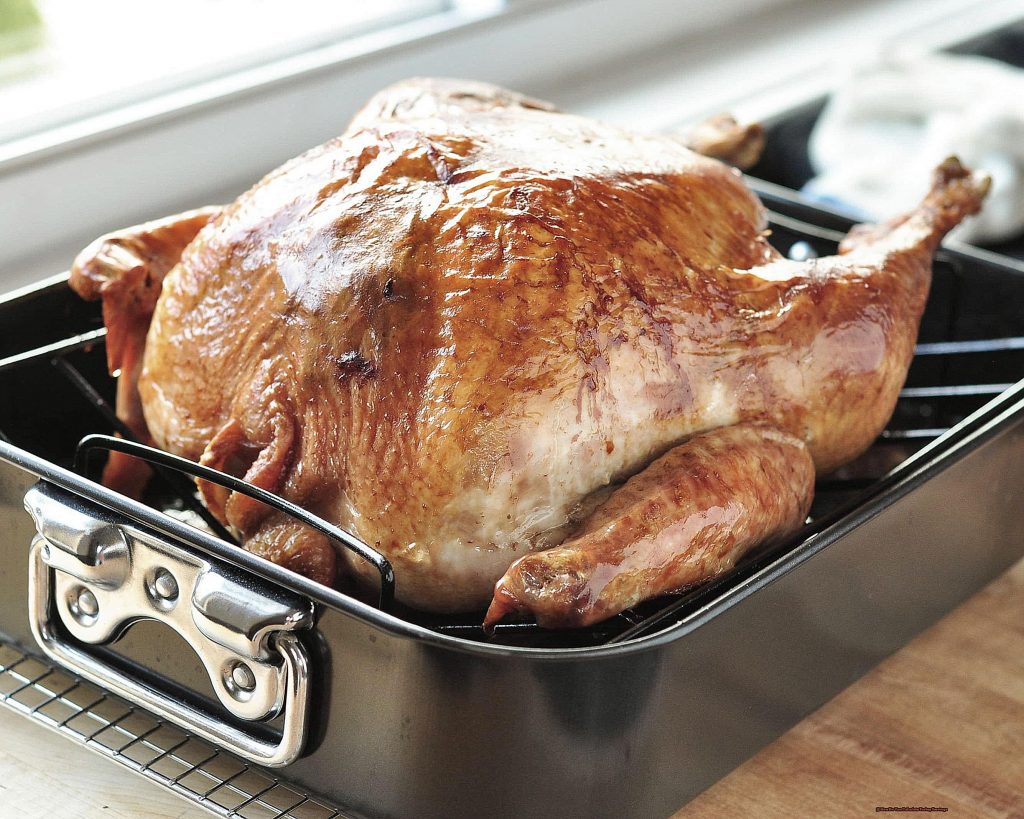Are you ready to impress your guests with a scrumptious Thanksgiving dinner? The star of the show is undoubtedly the turkey, but figuring out how much to buy can be daunting. Too little and hungry guests will leave unsatisfied, while too much means an abundance of leftovers. So, how do you calculate turkey servings?
Don’t worry – it’s not rocket science. Once you know the simple formula, it’s easy peasy. First, determine how many people you’ll be feeding and then multiply that number by the recommended serving size per person. Don’t forget to factor in whether or not you want leftovers.
This blog post goes beyond just calculating servings. We’ll dive into the nitty-gritty details of cooking a perfect turkey – discussing different cooking methods and preparations that can make all the difference in taste and texture. Plus, we’ll provide some tips for purchasing and preparing your bird like a pro.
By the end of this post, you’ll have everything you need to host a memorable Thanksgiving feast that will have your guests raving about your culinary skills for years to come. So let’s get started on making this year’s holiday one for the books.
Contents
Consider the Size of the Turkey
The size of the turkey is crucial in determining the number of servings it can provide. To accurately calculate how much turkey you’ll need, consider these important factors.
Let’s start with the type of event you’re hosting and the number of guests you are expecting. For a Thanksgiving dinner with lots of sides and desserts, slightly less turkey per person may suffice. However, if you’re hosting a more formal event with fewer sides and desserts, plan for slightly more turkey per person.
Next, think about the portion sizes you plan on serving. If you’re serving large portions, you will need more turkey per person. But if you have lots of sides or plan on serving smaller portions, you can get away with less turkey per person.
Lastly, take into account the size of the turkey itself. A smaller bird may have a higher ratio of bone to meat than a larger bird. So, if you have a smaller bird, plan for slightly more turkey per person than if you have a larger bird.
Remember that the general rule of thumb is to allow for about 1 pound of turkey per person. However, by considering these factors, you can ensure that you have enough turkey to go around without wasting any food.
To sum up, here are some tips for calculating the size of your turkey:
- Consider the type of event and number of guests.
- Think about portion sizes.
- Take into account the size of the turkey itself.
Plan for Leftovers
Planning for leftovers is key. As an expert on the topic, I am here to share some tips on how to calculate how much turkey you need to ensure you have enough for leftovers.
First and foremost, it is important to estimate how much turkey your guests will eat. A good rule of thumb is to plan for one pound of turkey per person. However, if you have some big eaters in your family or want to be sure there are plenty of leftovers, consider bumping that up to one and a half pounds per person.
Once you have your estimated total weight of the turkey, it’s time to subtract the weight of the bones. On average, about 40% of the weight of a turkey is in bones. For example, if you have a 15-pound turkey, subtract about 6 pounds for bones, leaving you with 9 pounds of meat.
Now that you know how much meat you have, it’s time to calculate how many servings you can expect. A standard serving size of turkey is approximately 4 ounces or ¼ pound. So, using our example of a 15-pound turkey with 9 pounds of meat, we can expect around 36 servings of turkey.
Remember that these calculations are just estimates and can vary based on appetites and other food options available. It’s always better to err on the side of caution and have more turkey than you think you’ll need. After all, who doesn’t love leftover turkey sandwiches?
When planning for leftovers, think about how you will store and use them. Leftover turkey can be used in a variety of dishes such as sandwiches, soups, casseroles, and more. Be sure to have plenty of storage containers and freezer space available so that you can keep your leftovers fresh and enjoy them for days after your holiday feast.
Appetite of Guests
It’s important to keep in mind that appetites vary greatly from person to person depending on factors such as age, gender, and activity level. Therefore, relying solely on general estimates won’t cut it. A good starting point is planning for about 1 pound of bone-in turkey per person or 3/4 pound of boneless turkey per person. However, it’s crucial to remain flexible and adjust based on your guests’ appetites.
One strategy to gauge your guests’ appetites is to do a quick survey or ask for RSVPs that include an indication of how much each guest typically eats. This will help you ensure that you have enough turkey to go around without overdoing it.
Another strategy is to offer a variety of side dishes and accompaniments that can help fill up guests who may not eat as much turkey.
Think creamy mashed potatoes, savory stuffing, crispy green beans, tangy cranberry sauce- all mouthwatering options that can round out the meal and ensure that everyone leaves feeling satisfied.
Let’s not forget about leftovers. Keep in mind that leftover turkey can be used in a variety of creative ways like hearty sandwiches and salads, nourishing soups, mouth-watering casseroles, and much more. So, if you’re a fan of leftovers (who isn’t?), factor those in when calculating how much turkey to serve.
Side Dishes and Appetizers
When it comes to Thanksgiving dinner, the turkey may be the star of the show, but the side dishes and appetizers are the supporting cast that really make the meal shine. As an expert on side dishes and appetizers, I’m here to guide you through how to calculate the perfect amount of these delicious accompaniments.
First things first, consider how many guests you’re expecting. As a general rule of thumb, plan for one pound of turkey per person. This means if you’re serving a 20-pound turkey, you can expect to feed around 20 people.
Next, think about the types of sides and appetizers you want to serve. A variety of options is key to catering to different tastes and dietary needs. Classic Thanksgiving sides like mashed potatoes, green bean casserole, cranberry sauce, stuffing, and deviled eggs are always popular choices. But don’t be afraid to mix in some unique options like roasted veggies or sweet potato casserole.
Once you’ve chosen your sides and appetizers, it’s time to determine how much of each dish to make. Consider portion sizes when doing your calculations – aim for around 1/2 cup of mashed potatoes per person and 1/3 cup of green bean casserole per person as a general guideline. However, adjust based on how hungry your guests are and how many sides you’re offering.
Remember to factor leftovers into your calculations as well. If you want to have plenty of turkey and sides for the next day, plan for slightly more servings than the number of guests you’re expecting.

Timing and presentation are also important considerations. Make sure all your sides and appetizers are ready to serve at the same time as the turkey so that everything is hot and ready to eat. And don’t forget about visual appeal – take some extra time to make everything look beautiful on the table.
General Rule of Thumb
As the holiday season approaches, many of us are gearing up to plan our Thanksgiving menus. And when it comes to the centerpiece of the feast – the turkey – there’s always that looming question: how much do I need? Fear not, for as an expert in all things food-related, I’m here to share with you the general rule of thumb for calculating turkey servings.
First and foremost, it’s important to estimate about 1 pound of turkey per person. But bear in mind that this calculation can vary depending on a few factors, such as the size of the bird, whether or not it is bone-in, and if you plan on having leftovers. With these factors in mind, you can adjust your calculations accordingly.
If you’re unsure about what size turkey to purchase, always err on the side of caution and buy a larger bird. This way, you’ll have enough turkey for everyone to enjoy and possibly even some leftovers for the next day. Plus, let’s be honest, who doesn’t love a good turkey sandwich?
When it comes to meal planning, another factor to consider is the type of spread you’ll be serving. If you’re planning an extravagant feast with multiple side dishes and desserts galore, you can get away with slightly less turkey per person. However, if you’re only serving a few sides, a larger bird may be necessary.
But no matter how much turkey you decide to cook up, it’s crucial to remember that cooking times will vary based on the size of the bird. A general rule of thumb is to cook the turkey for 15-20 minutes per pound at 325°F. However, don’t rely solely on this calculation – always use a meat thermometer to ensure that the internal temperature has reached 165°F before serving.
Calculating Amounts for Large Groups
Don’t let the thought of calculating the right amount of turkey servings stress you out. As an expert in all things food-related, I’m here to guide you through the process. Here’s how to ensure that all your guests are satisfied with their portion:
- Size Matters: One of the first things to consider when calculating the amount of turkey needed is the size of the bird. A general rule of thumb is to plan for at least 1 pound of turkey per person. If you have 20 guests, then a 20-pound turkey would be perfect. However, don’t hesitate to buy a larger bird if you’re feeding more people.
- Consider Your Crowd: It’s important to factor in your guests’ eating habits when deciding on the amount of turkey needed. If you’re serving a group of heavy eaters or many children, it may be wise to plan for slightly more than 1 pound per person. Conversely, if your guests are light eaters or if you have an abundance of side dishes, you may be able to get away with slightly less.
- Dietary Restrictions: Be mindful of any dietary restrictions or preferences within the group. If you have vegetarians or individuals who do not eat turkey, make sure to provide alternative main dishes or sides. Additionally, take into account specific dietary needs such as gluten-free or lactose-free and have suitable options available.
- Leftovers: Lastly, it’s essential to consider how much leftovers you want after the meal. Some people love having plenty of leftovers for sandwiches and meals in the following days, while others prefer to have minimal leftovers. Plan accordingly based on your preferences and those of your guests.
Tips for Making Accurate Calculations
The centerpiece of any Thanksgiving or holiday feast is usually the turkey. However, getting the right amount of turkey to serve your guests can be tricky. Here are some essential tips to help you make accurate calculations:
Determine the Weight of the Turkey
The weight of the turkey is a crucial factor in calculating the number of servings. A general rule of thumb is to plan for one pound of turkey per person. This means if you have ten guests, a turkey that weighs around 10 pounds should suffice.
Consider the Type of Turkey
The type of turkey you choose can also affect your calculations. For example, a bone-in turkey will have less meat than a boneless turkey of the same weight. Additionally, a turkey with more white meat will yield more servings than one with more dark meat.
Account for Leftovers
Everyone loves leftovers, so it’s better to have too much than too little. When calculating servings, consider that some people may want seconds or thirds, and there may be leftovers that can be used for sandwiches or other meals. Plan for an extra half-pound of turkey per person if you want leftovers.
Adjust for Appetites
It’s essential to keep in mind that some guests may have larger appetites than others. If you have a group of big eaters, plan for slightly more than one pound of turkey per person.
Use a Serving Size Chart
To make accurate calculations, it’s helpful to use a serving size chart that shows how much turkey each person will need. This can vary depending on whether you are serving adults or children and how many sides and desserts you plan to serve.
Conclusion
In conclusion, determining the appropriate amount of turkey servings for your Thanksgiving feast need not be a daunting task. With these simple tips and tricks, you can effortlessly calculate how much turkey you need to serve your guests without any stress or anxiety.
Firstly, take into account the size of your turkey and the number of guests you will be entertaining. While it is generally recommended to plan for one pound of turkey per person, factors such as portion sizes and bone-in versus boneless can influence this calculation.
Moreover, it is essential to consider leftovers and cater to varying appetites. Plan for slightly more than one pound per person if you want ample leftovers or if you are feeding a group of hearty eaters.
Lastly, do not overlook side dishes and appetizers. Offering an array of options can satiate guests who may not consume as much turkey while adding some extra flavors to your meal.
By bearing these tips in mind, you can easily determine the perfect amount of turkey servings for your gathering.






